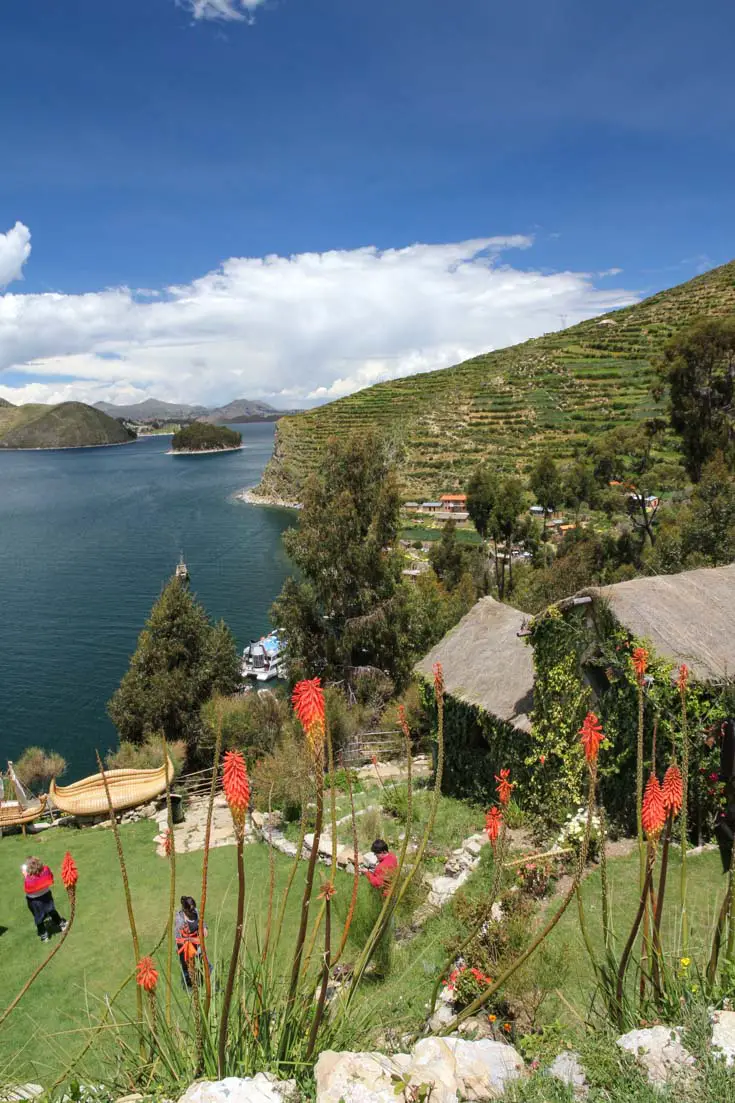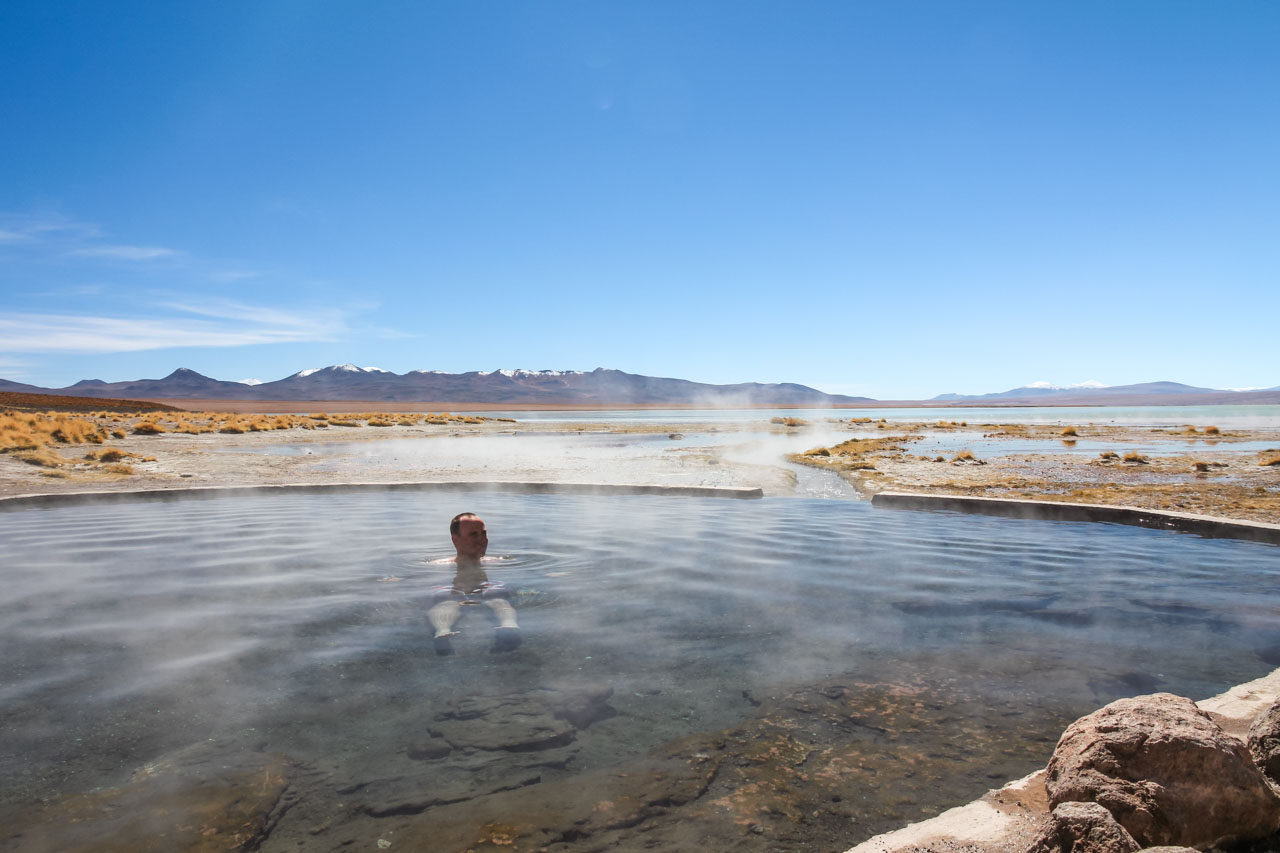One of the most memorable parts of our month in South America was the 6-days we spent crossing the Bolivian Altiplano. The Altiplano is a high plateau in the Andes mountain range, averaging 3,750-meters (12,300-feet) in height. As James aptly remarked, “if we were in Australia right now, we would be in the flight path!” Here you’ll find some of Bolivia’s most remote and awe-inspiring landscapes, including the world’s largest salt flat. Let’s explore!
Where is the Bolivian Altiplano?
The Altiplano is located at the widest part of the Andes. Though most of it lies within the borders of Bolivia, the fringes of the enormous plateau spill into parts of Peru, Chile and Argentina. The Andean Plateau begins with Lake Titicaca in the north. It tracks the western border with Chile, to a desolate corner of the country where it reaches Argentina in the south.
Getting to the Bolivian Altiplano
Depending on your point of origin, there are several ways to reach the Bolivian Altiplano:
- From Chile, you could cross the border from San Pedro de Atacama on wheels travelling the following itinerary in reverse.
- Those travelling from Peru, may make a land crossing into Bolivia near Lake Titicaca.
- Lastly, there is the option of flying into La Paz.
When to visit the Bolivian Altiplano?
The Andean Plateau experiences two distinct seasons: a wet, temperate summer (December to April) and dry, cold winter (May to November). Sights such as the Salar de Uyuni (Uyuni Salt Flat) might be inaccessible during the wet season due to flooding, so it is best to visit during the winter months. We travelled in April, catching the tail end of the wet season. Though the weather was fine, the Salt Flat was still considerably flooded which prevented us from reaching some areas. June through August are the high season with increased numbers of visitors and higher hotel rates.



7-Day Bolivian Altiplano highlights itinerary
Day 1: Lake Titicaca
Our Altiplano journey began on the Peruvian side of the Andean plateau, following our trek to Machu Picchu. We boarded a bus from Cusco to the city of Puno, on the shores of Lake Titicaca, South America’s largest lake. Here we visited the floating islands of the Uros people and learnt about the community’s unique lifestyle on an archipelago of human-made islands constructed with reeds.
The following day we continued by tourist bus to the Bolivian border. The bus itself cannot leave Peru, so it’s necessary to disembark with your luggage and walk the last short section across the border. From there we alighted a new bus for a short drive into the original Copacabana, namesake of the Brazilian city.
After a brief tour of Copacabana, we boarded a catamaran on Lake Titicaca. The boat took ferried us Isla del Sol (Island of the Sun), a significant pilgrimage site in Incan times. The Island is set up with a living museum showcasing local history and culture. Here, the picturesque Lake Titicaca could be mistaken for the Mediterranean and we did indeed enjoy a lot of sun! From the shores of Isla del Sol, we returned to the mainland for an evening transfer by bus to La Paz.
Day 2: Exploring La Paz
We spent one full day in La Paz divided between a guided city tour and the Valle de la Luna (Valley of the Moon). Our city tour took us through the historic district from the oddities of Mercado de las Brujas (Witches Market), to the colonial architecture of Plaza Murillo and the panoramic views of Mirador Killi Killi. We learnt about the history of La Paz and broader Bolivia.
In the afternoon, we explored Valle de la Luna, a unique geological formation just south of the capital. The Valley is home to clay and sandstone hoodoos shaped by wind and water. This unusual landscape of clay stalagmites and craters, will eventually be destroyed by these same forces of nature.
Local lore tells of Neil Armstrong visiting here in 1969 after his moon landing, and comparing it to the lunar surface. Hence it was dubbed “Valle de la Luna”.







Day 3: La Paz to Uyuni
From La Paz we continued our journey south with a 4-hour bus ride to the mining town of Oruro. After lunch in a local restaurant we hopped aboard Expreso del Sur for a train ride of 7-hours to Uyuni. With upgraded tickets, we were very comfortable with a meal and movies to keep us entertained once the sun dipped on the Altiplano scenery out our windows.
Day 4: Bolivian salt flats and train cemetery
After a good night’s rest we started our exploration of Salar de Uyuni (Uyuni Salt Flats). This included wading around shin-deep in leftover wet season floodwaters that turn the flats into the “world’s largest mirror”. We fooled around with optical illusions, taking endless photos while our guide and driver set up a picnic lunch in the shallows.
The deeper waters prevented us from reaching the giant cacti on Incahuasi Island, the tip of a volcano protruding from the salty desert. Instead, we proceeded to the eerie Train Graveyard. The photogenic site is a boneyard of corroded train skeletons. They were left to rust in the salty winds after the railroad was abandoned in the 1940s.
Our evening accommodation was an experience in its own right. The Palacio del Sal (Palace of Salt), is a hotel constructed largely of salt, including walls, floor, sections of ceiling and furniture. Adding to our experience was the fact we were the only guests on a quiet, shoulder-season evening. The Salt Palace is one of the most unique accommodations of all our travels to date and I highly recommend spending at least one night.





Day 5: Rock formations, curious flora and ancient rock art
With a guide and driver to navigate us across the disorienting desolate highlands, we continued traversing the plateau’s distinctive landscapes. Along the way we stopped to climb wind-sculpted rock formations. We observed large specimens of the particularly slow-growing Azorella compacta, that resembles like moss covered boulders, and visited ancient rock paintings. We lunched in a seemingly abandoned village, built on the economies of mining and llama herding.
In fact, the town of Villamar where we spent the night in a cozy cavern-like guesthouse, had only begun to receive electricity 6-months before we arrived. Molten wax-covered candleholders were evidence of how recently they had been reliant on raw fire for heat and light. Outside the guesthouse, a stream wound its way around the feet of grazing llamas. We played catch with the owners’ son, as she cooked us a hearty dinner..



Day 6: Deserts, lakes and geysers
Our last day on the Bolivian Altiplano was possibly the most spectacular! We drove the final leg through Eduardo Avaroa Andean Fauna National Reserve to the Chilean border. Along the way we crossed a desert named for its resemblance to the barren red landscapes in Salvador Dali paintings. There were stops for steaming geysers and a dip in thermal pools.
A series of lakes presented an interesting selection of ecosystems. One housed a flamboyance of pink flamingos feeding on resident algae. Another was devoid of wildlife altogether as a lethal hue of turquoise signaled its high levels of naturally-occurring arsenic.
Our Bolivian Altiplano journey came to a close as we traversed the border into Chile. The process involved the most absurd, amusing and potentially worrying border crossing. It felt a little like a prisoner exchange. We bid goodbye to our Bolivian guide and driver at a shack surrounded by nothing but volcano peaks. Thankfully, tour agency coordinated the hand-off seamlessly and we were promptly received by our Chilean hosts on the other side of a futile boom gate.





Adios Altiplano!
The subsequent descent off the edge of the plateau into the Atacama Desert was nothing short of epic. Out of the vehicle’s rear window, we watched the Altiplano rising behind us, like a giant wall.
I hope you are feeling inspired by the sensational landscapes and remote beauty of this Bolivian Altiplano itinerary. If you have any questions, please leave them in the comments at the end of this post.
Peace, love and inspiring travels,
Madam ZoZo


2 comments
This post just made me so excited for our future trip to South America. This is definitely on my list! Thanks for sharing!
Glad you found it inspiring Kat! Bolivia really is an incredible place, and spending time in remote locations with few creature comforts gives you a such different perspective on life.